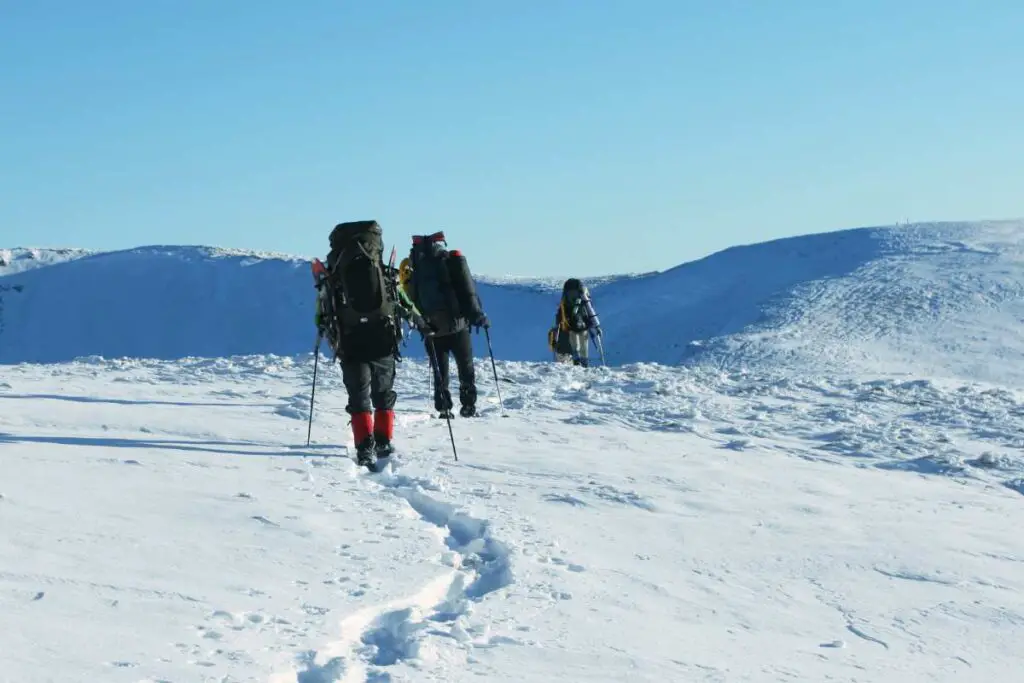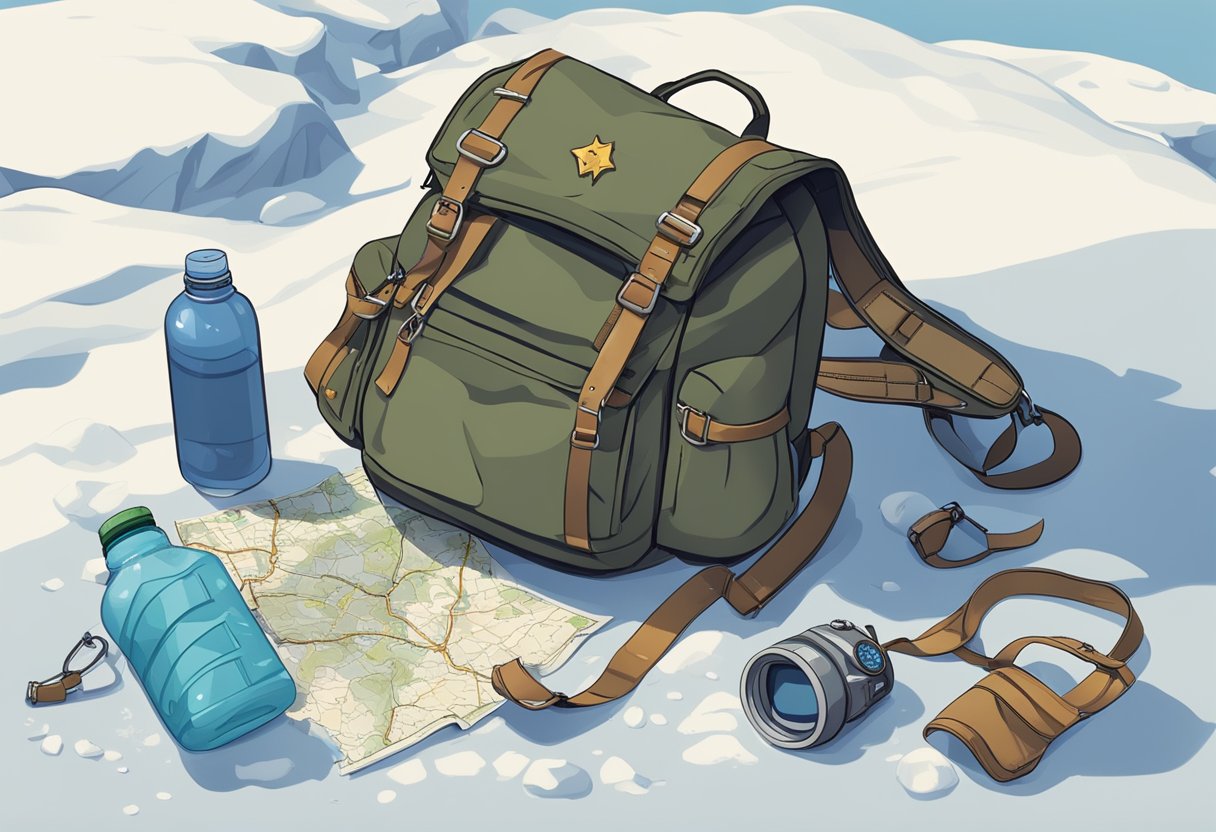Winter hiking offers a unique opportunity to experience the beauty and serenity of nature during its colder months.
However, venturing out into frosty landscapes also comes with its fair share of challenges and potential dangers.
To ensure a safe and enjoyable winter hike, it’s essential to be aware of common mistakes that can turn your adventure into a perilous ordeal.
One vital aspect of winter hiking is dressing appropriately for the weather conditions.
Wearing layers is crucial in maintaining a comfortable body temperature, as it allows for easy adjustment to changing conditions.
A proper layering system consists of a moisture-wicking base layer, an insulating mid-layer, and a shell layer to protect against the elements.

Hypothermia, caused by abnormally low body temperature, is a significant concern during winter hikes and can be life-threatening if not addressed promptly.
Moreover, many winter hiking mishaps result from poor planning and lack of preparedness.
It’s important to:
- research the trail conditions and potential risks
- carry essential gear
- and be knowledgeable about recognizing and responding to hazards such as frostbite or hypothermia.
By avoiding common mistakes, winter hikers can safely embrace the cold season’s wonders and reap the rewards of a successful adventure.
Understanding Winter Hiking

Winter hiking offers an unparalleled experience, as the world transforms into a serene wonderland.
However, cold weather hiking comes with its unique set of challenges. This section aims to provide a better understanding of winter hiking, highlighting essential tips and possible pitfalls.
In winter, the weather can turn unpredictable, requiring hikers to be vigilant. It’s crucial to check the weather forecast and plan accordingly, allowing ample time for rest and unexpected delays.
Successful cold-weather hiking necessitates a proactive approach in addressing any potential risks.
Proper clothing and gear are essential for winter hiking. Layering clothes can help hikers maintain a comfortable body temperature while effectively managing sweat.
Here is a suggested layering system:
- Base layer: Moisture-wicking material (e.g., synthetic fabric, wool) to keep the skin dry
- Insulation layer: A good insulating material (e.g., fleece, down, etc.) to trap body heat
- Outer layer: A waterproof and wind-resistant shell to protect from the elements
Footwear is also a critical aspect of winter hiking gear. Insulated boots with a good grip help hikers navigate snowy and icy terrain confidently.
Additionally, gaiters and microspikes can provide extra traction and protection.
One of the most common winter hiking mistakes is not staying adequately hydrated. Cold weather triggers a decreased thirst response, misleading hikers into thinking they do not need as much water as they do.
Maintaining proper hydration is critical for physical and mental performance during winter hikes. Therefore, hikers should remember to drink water regularly, even if not feeling thirsty.
Winter hikers must be aware of their surroundings and understand the dangers that cold weather can bring.
Hypothermia and frostbite are two significant hazards. To avoid these, hikers should prevent sweating by dressing appropriately, not overdressing, and taking breaks to cool down if necessary.
Furthermore, hikers should be aware of the warning signs of hypothermia and frostbite and take immediate action if they suspect either condition.
Navigation during winter hikes can be more challenging as snow often covers trails and reduces visibility.
Hikers should carry maps, compasses, and GPS devices, and be confident in their ability to use them effectively. Moreover, hikers must be prepared for early sunsets and carry headlamps or flashlights for any nighttime navigation.
By understanding and preparing for the various aspects of winter hiking, hikers can enjoy breathtaking landscapes while staying safe and comfortable during their cold-weather adventures.
Common Mistakes and How to Avoid Them

Layering Issues
One common mistake that winter hikers often make is not dressing properly. To avoid hypothermia and ensure your comfort, it’s essential to wear appropriate clothing layers.
A proper layering system should include a moisture-wicking base layer, an insulating mid-layer, and a waterproof outer layer.
- Base layer: Choose moisture-wicking materials like merino wool or synthetic fabrics. Avoid cotton, as it retains moisture and can quickly make you feel cold.
- Mid-layer: Fleece or down jackets work well for insulation and trapping heat.
- Outer layer: A waterproof and breathable shell will protect you from snow, rain, and wind.
Another critical aspect of layering to keep in mind is your extremities. Be sure to wear insulated gloves, warm socks, and a winter cap or balaclava to keep your head, hands, and feet warm.
Hydration and Nutrition Blunders
Winter hikers often forget about the importance of staying hydrated and well-nourished.
Cold weather can suppress your thirst, leading to dehydration without realizing it. Remember to carry and drink water regularly, even if you don’t feel thirsty. Insulated water bottles or hydration reservoirs can help prevent your water from freezing.
Likewise, hiking in cold weather burns more calories, so pack plenty of nutritious snacks and meals to keep your energy levels up.
Stay away from sugary snacks and opt for protein-rich foods like nuts, dried fruits, and whole-grain energy bars.
Navigation Pitfalls
In winter, it’s crucial to research your chosen trail before heading out, as snow and ice can obscure trail markers, making it easier to get lost.
Ensure you have a good understanding of the trail’s length, difficulty, and topography. Additionally, consider carrying a map, compass, and GPS device as backups.
Always inform someone of your planned route and estimated return time. This way, if you encounter any issues, it will be easier for rescuers to locate you.
Finally, be prepared to change your plans or turn back if the conditions worsen or if you’re unsure of your route. It’s better to stay safe than risk getting stranded in the cold.
Choosing the Right Gear

A successful winter hike starts with the right gear selection.
Wearing and carrying proper equipment is crucial for comfort, safety, and overall experience.
Here are some essential items to consider when planning your next cold-weather trek:
- Footwear: Opt for waterproof hiking boots with good insulation and traction. A sturdy pair of boots will keep your feet warm and dry while providing support on slippery trails. In addition, consider using crampons or microspikes for increased grip on icy surfaces, and gaiters to protect your lower legs from snow and moisture.
- Clothing: Layering is key to staying warm and comfortable during a winter hike. Avoid cotton, which retains moisture and can lead to hypothermia. Instead, choose moisture-wicking base layers, insulating mid-layers, and windproof and waterproof outer layers. Don’t forget essential accessories like gloves, a hat, and warm socks.
- Hiking Poles: These provide additional stability and support, especially on icy or snow-covered terrain. They also help redistribute weight, reducing strain on your legs and knees.
- Backpack: The right hiking backpack should be large enough to carry all your gear and supplies while fitting comfortably on your body. Make sure it’s made from water-resistant material and is easy to access, even with gloves on.
- Headlamp: Winter days are shorter, and a good headlamp is essential for navigating in low-light conditions. Choose one with a bright, adjustable beam and long battery life.
- Snowshoes: In areas with deep snow, snowshoes can provide much-needed flotation to keep you from sinking into the snow. Make sure to select the appropriate size and style for your intended terrain.
- Knife: A versatile knife can be a lifesaver in emergency situations, from cutting rope to preparing food. Opt for a lightweight, durable, and easy-to-handle design.
When choosing your winter hiking gear, prioritize quality, functionality, and warmth. Properly equipping yourself can lead to a more enjoyable and safer outdoor experience.
The items listed above form a strong foundation for your winter hiking kit, ensuring you’re prepared to face the cold weather and snowy trails with confidence.
Preparation and Safety Measures

When embarking on a winter hike, it is essential to be well-prepared and prioritize safety.
Firstly, dressing in layers is crucial. Start with a moisture-wicking base layer to draw sweat away from your skin. Avoid wearing cotton since it retains moisture and can cause hypothermia. Add an insulating layer for warmth, followed by a waterproof and windproof outer layer to protect against harsh weather conditions.
Remember to manage your sweat and avoid overheating. This prevents damp clothes, which can lead to hypothermia. Remove or add layers as needed to maintain a comfortable temperature.
Pay attention to hydration and food during a winter hike. Bring a well-insulated water bottle to prevent freezing and consume adequate liquids to avoid dehydration. Pack high-energy snacks to sustain energy levels throughout the hike.
Equip yourself with essential items for any emergencies. These include an emergency shelter, first aid kit, compass, and extra clothing. Avoid wearing tight clothing to maintain proper blood circulation.
Be aware of avalanche safety measures when hiking in snowy areas. Learn about avalanche terrain and signs of unstable snowpack. Carry appropriate safety gear like an avalanche beacon, probe, and shovel.
Remember to check the weather forecast before heading out and monitor trail conditions for possible hazards. Plan your hike during daylight hours to ensure enough time to return safely. In case of worsening weather or other unexpected situations, prepare a plan B and be willing to turn around.
Ensure your phone is charged and has sufficient battery life. Consider carrying spare lithium batteries or portable chargers, as cold temperatures can quickly drain batteries. In the same vein, pack hand warmers to maintain feeling and warmth in your extremities.
Finally, consider the advantages of snowshoeing for better traction in deep snow and bringing additional traction devices for icy trails. Acknowledge that winter camping comes with additional challenges and layering requirements compared to day hikes.
By adhering to these safety tips and understanding the layering basics, hikers can significantly minimize risks and prevent dangerous situations, resulting in a safer and more enjoyable winter hiking experience.
Caring for Your Gear

Proper care and maintenance of your winter hiking gear are crucial to ensure their longevity and effectiveness.
Focusing on key equipment such as down clothing, headlamps, backpacks, phones, crampons, gaiters, first aid kits, navigation tools, water bottles, hiking boots, emergency shelters, and much more will provide a safer and more enjoyable hiking experience.
Here is the list you should consider:
- Down Clothing: It is important to keep down garments clean and dry. When washing, use a gentle detergent specifically designed for down products. Avoid overwashing, as this can harm the down’s insulating properties. Dry apparel thoroughly, preferably using air-drying methods.
- Backpacks, Gaiters, and Waterproof Hiking Boots: After each hike, clean these items thoroughly. Remove dirt, grime, and snow to prevent damage. Allow them to dry properly before storing to avoid mildew or mold development. Ensuring zippers and straps are functioning properly is also essential.
- Crampons and Microspikes: Regularly inspect your crampons and microspikes for wear and tear. Rust or damage can impact their effectiveness. Clean and dry them after each use to prolong their lifespan.
- First Aid and Navigation: Keep your first aid kit well-stocked and in good condition. Always ensure that essential items such as a knife, compass, and cellphone are present and functional. Store all items in a waterproof container or pouch.
- Water Bottles and Filters: Empty and clean water bottles after each hike. For water filters, follow the manufacturer’s instructions to clean and maintain them properly. Keep water reservoirs and bottles in insulated sleeves to avoid freezing during hikes.
- Electronic Devices: Keep your phone and headlamp in a protective case or bag. Ensure their batteries are charged before setting off, and carry spare batteries or a portable charger. Using moisture-wicking fabrics or a waterproof case can help protect devices in wet conditions.
When planning a winter hike, consider factors like daylight hours, trail conditions, and appropriate gear for snowshoeing and traction.
Familiarize yourself with the Outside+ app for updated information on hiking trails and conditions. To stay warm, wear base layers made from wicking fabrics and moisture-wicking clothing.
Equip yourself with hand warmers, hiking poles, and a comfortable hiking backpack for better support and stability.
By properly caring for your winter hiking gear, you can effectively avoid common mistakes and enjoy a safe, comfortable, and exciting hiking experience.






